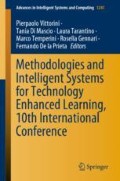Abstract
The design of learning activity and paths in informatics is made difficult on the one hand by the absence of a well-established tradition of teaching computer science and on the other by the fact that in many countries the official curricular recommendations are moving towards a competency-based model, increasing the responsibility of teachers. Motivated by the current state of informatics education in Italy, this work presents a system realized to support the research and classification of teaching activities in order to better select the most appropriate ones for the achievement of predetermined learning objectives. A wizard is also provided that allows teachers to use selected activities to design articulated learning paths. The system is designed to be used in the context of a community of practice involving teachers and experts in informatics education, in which innovative learning activities and paths are proposed, validated and shared.
Access this chapter
Tax calculation will be finalised at checkout
Purchases are for personal use only
Notes
- 1.
This paper uses the term “informatics”, that is more common in continental Europe than “Computer Science”.
- 2.
The term Digital Literacy denotes practical skills in the use of computers, software and other digital tools every citizen should be familiar with, to live in the 21st century, as described in more detail, for instance, in [13].
- 3.
“Programma il Futuro” is a initiative put in place by MIUR and CINI to promote informatics education in Italy, by offering ready-to-use teaching resources, many of which are the Italian translation of materials designed for the Code.org organization.
- 4.
References
Bellettini, C., Lonati, V., Malchiodi, D., Monga, M., Morpurgo, A., Torelli, M., Zecca, L.: Informatics education in italian secondary schools. TOCE 14(2), 15:1–15:6 (2014)
Computing at School Working Group: Computer science: A curriculum for schools (2012). www.computingatschool.org.uk/data/uploads/ComputingCurric.pdf
Consorzio interuniversitario nazionale per l’informatica (CINI): Proposal for a national informatics curriculum in the Italian school (2017). https://www.consorzio-cini.it/images/PROPOSAL-Informatics-curriculum-Italian-school.pdf
Department for Education: National Curriculum for England: Computing programme of study. Technical report (2013). https://www.gov.uk/government/publications/national-curriculum-in-england-computing-programmes-of-study/national-curriculum-in-england-computing-programmes-of-study
European Parliament: Recommendation 2006/962/ec of the European parliament and of the council of 18 dec. 2006 on key competences for lifelong learning (2006)
Forlizzi, L., Lodi, M., Lonati, V., Mirolo, C., Monga, M., Montresor, A., Morpurgo, A., Nardelli, E.: A core informatics curriculum for Italian compulsory education. In: Pozdniakov, S.N., Dagiene, V. (eds.) Informatics in Schools Fundamentals of Computer Science and Software Engineering ISSEP 2018. LNCS, vol. 11169, pp. 141–153. Springer, Cham (2018)
Forlizzi, L., Melideo, G., Rosa, G., Scafa Urbaez Vilchez, C.: Dalla proposta di indicazioni nazionali per l’insegnamento dell’informatica ai percorsi formativi: Strumenti operativi per la scuola primaria. In: Didamatica 2019 Informatica per la Didattica, Atti del Convegno, pp. 105–114 (2019)
Hromkovic, J.: Contributing to general education by teaching informatics. In: Mittermeir, R.T. (ed.) Informatics Education - The Bridge between Using and Understanding Computers, ISSEP 2006. LNCS, vol. 4226, pp. 25–37. Springer, Cham (2006)
Legge 13 luglio 2015, n. 107: Riforma del sistema nazionale di istruzione e formazione e delega per il riordino delle disposizioni legislative vigenti (2015). https://www.gazzettaufficiale.it/eli/id/2015/07/15/15G00122/sg
MIUR: Indicazioni nazionali per il curricolo della scuola dell’infanzia e del primo ciclo d’istruzione (2012). http://www.indicazioninazionali.it/wp-content/uploads/2018/08/Indicazioni_Annali_Definitivo.pdf
MIUR: Piano nazionale scuola digitale (pnsg) (2015). http://www.istruzione.it/scuola_digitale/allegati/Materiali/pnsd-layout-30.10-WEB.pdf
Rich, K.M., Strickland, C., Binkowski, T.A., Moran, C., Franklin, D.: K-8 learning trajectories derived from research literature: sequence, repetition, conditionals. Inroads 9(1), 46–55 (2018)
The Committee on European Computing Education (CECE): Informatics education in Europe: Are we all in the same boat? Technical report (2017)
The White House: Report on the initiative “computer science for all”. Technical report (2016). https://www.whitehouse.gov/blog/2016/01/30/computer-science-all
Wing, J.M.: Computational thinking. Commun. ACM 49(3), 33–35 (2006)
Wing, J.M.: Computational thinking: What and why? The Link Magazine (2011)
Acknowledgements
This work was partially developed within the framework of the Informatics and School National Laboratory of CINI (National Interuniversity Consortium for Informatics).
The authors are thankful to Paolo Tramontozzi and to Stefano Florio for implementing several features of the system as part of their bachelor’s thesis.
Author information
Authors and Affiliations
Corresponding author
Editor information
Editors and Affiliations
Rights and permissions
Copyright information
© 2020 The Editor(s) (if applicable) and The Author(s), under exclusive license to Springer Nature Switzerland AG
About this paper
Cite this paper
Forlizzi, L., Melideo, G., Vilchez, C.S.U. (2020). Supporting the Construction of Learning Paths in a Competency-Based Informatics Curriculum. In: Vittorini, P., Di Mascio, T., Tarantino, L., Temperini, M., Gennari, R., De la Prieta, F. (eds) Methodologies and Intelligent Systems for Technology Enhanced Learning, 10th International Conference. MIS4TEL 2020. Advances in Intelligent Systems and Computing, vol 1241. Springer, Cham. https://doi.org/10.1007/978-3-030-52538-5_19
Download citation
DOI: https://doi.org/10.1007/978-3-030-52538-5_19
Published:
Publisher Name: Springer, Cham
Print ISBN: 978-3-030-52537-8
Online ISBN: 978-3-030-52538-5
eBook Packages: Intelligent Technologies and RoboticsIntelligent Technologies and Robotics (R0)

